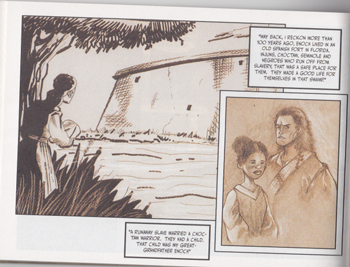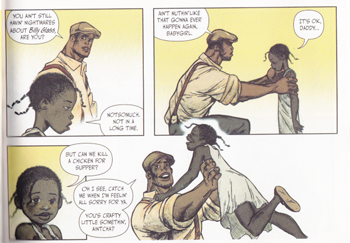This is a beautiful and haunting comic. It’s kind of what I had hoped and expected to feel after reading Swamp Thing, to be honest. Not the parts about racism, but the parts about the feeling of the swamp as a powerful life force that cannot be controlled and that contains far more life in far stranger ways than we can admit to ourselves. A life that can tell us odd stories and take us on strange journeys.
Bayou is, I would say, a folk tale, a fairy story.
If anyone thinks I just conjured a Disney Princess, then think again. The kind of folk tale where the stepmother cuts off her own daughters heels to fit into the glass slipper and the blood flows and the songbird of a dead relative cries out to warn the prince. Yeah.
But that’s to compare Bayou to a set of stories, a set of myths, that it isn’t really drawing against. Bayou bears more resemblance, I think, conjures more magic from, the vein of stories like The Velveteen Rabbit and Brer Rabbit. Because Bayou is a children’s story, terrifying as that may seem, and it *is* terrifying.
Bayou tells the tale of Lee, a little girl living with her single dad on a share cropper farm in the deep South in the 30s. The story begins when Lee, holding onto a rope her dad holds, goes swimming in the bayou to fetch out the corpse of a black boy who’d been lynched for whistling at a white woman.
When Lee goes under the water, she is changed. She finds the body and helps it out, but she also sees the boy’s soul, adorned with butterfly wings.
This first glimpse sets the tone of the story, for when Lee returns to her normal home, where they have fried chicken for supper and her daddy laughs and carries her tall, it’s a contrast, but not just between the swamp and the normal, but between black life and white life. Her daddy is a hard working, great big man, and he tells Lee about the compromises they have to live under, doing what they must to survive in an unfair, brutal world where boys get killed for whistling and to question that is to be killed, too.
It made my stomach hurt, and at first, I admit I thought, “How is this a story for children?” But of course that’s stupid of me.
What adults do to one another is often in front of children, and includes them. That’s life. This is the story of that brutal, ugly racism during that time, not as it applied to adults, but as it applied to a little girl. Which, yes, does make my stomach hurt. But that’s OK. It should.
It’s not about white people doing terrible things to black people, so much as it is about the little girl in her own side of the world, and what she chooses to do about those things. Which makes it a story that kept me up and gave me nightmares, because Lee is one brave, scary, awesome little girl.
So, as one might expect from an intro with pulling a dead, lynched corpse from the swamp, Lee’s daddy gets in trouble because Lee’s best friend did what kids do when they’re in trouble, which is to lie a little bit. She and Lee play by the edge of the Bayou, and a Bayou monster steals her necklace. She lies about where it went stolen, gets eaten, and the town blames Lee’s daddy. Lee goes after the monster, Cotton Eye’d Joe, to save her daddy and to free her friend. I gnawed on a lock of hair while I was reading this damn comic, which I haven’t done since I was like, I don’t know, seven. It’s that scary.
Lee runs into various magical people of the swamp, and they are so real. So internally right.
And I keep talking about this story as though maybe it is just a story and not a comic specific story, but that’s because the art is so integral that I can’t separate it out to even look at it separately from the perspective of art vs story. It’s all of a piece. You couldn’t just tell this story with pictures nor could you just tell it with words. They’re together, intertwined.
Which is how it should be.
So far I haven’t scanned in any pictures, but here are a few to give you a hint of what I mean. The story is so much from Lee’s perspective that the adults are huge and some are scary in themselves. I love this passage about Lee and her daddy. Their features are so well drawn, their emotions so clear.
And the colors in this comic are so….rich and lush and right. The everyday colors are dull brown and blue, and the swamp adds amazing surprise butterfly colors, as swamps do. Did you know that orchids are swamp flowers? Sudden surprising orchids don’t show up, but that’s the sort of thing I mean. Here, see these wings ?
?
The bugs, butterflies, and rabbits are everywhere, as they are in that part of the world, coming through in surprising flashes when one least expects it. The creatures who are magic appear this way and so do the strange happenings, which feel less like artificial imported Alice in Wonderland capes-comic BS, as they do the mere writing down of observation of existing entities.
There are some internally told stories and they gave me the shivers, too. They are beautifully portrayed and of a piece; one is retold in the past, starring that old cruel man, Old Hickory, Andrew Jackson, and it’s drawn in crayon’d sepia that seemed just right:
This a haunting comic, a scary comic, a wonderful comic. I have preordered volume 2. Highly, highly recommended.



All right, you need to scan images at a higher dpi VM. At this size these are really hard to see.
Have you read Zora Neale Hurston? This sounds a little bit like her…she occasionally mixed some folk tales and fantasy in her books (there’s a lovely story about a man turning into an alligator in her autobiography.)
*sigh* Every time I scan images at larger than the dpi width that they’re posted as (350 width is what generally fits, ime), the image editor crashes.
I haven’t read Hurston in a long time, but it reminded me a bit of Morrison’s Beloved.
ETA, should I try using Photobucket again or something?